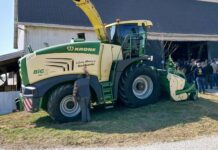
The black ducks are back. They and Canada geese fly in formation over the pool that never freezes, so they can spend the winter there and breed in the spring.
Hundreds of great blue heron nests dot the trees around the pool, though a pair of bald eagles was allowed to rent space in the heronry, too. Trumpeter swans paddle through the still water, or stand guard over nests on the shore. Pairs of sandhill cranes soar with necks outstretched as they search for muskrat huts or other suitable places to nest.
All of these could be seen on an afternoon in May at the Killbuck Marsh Wildlife Area near Shreve. But it’s only been in the last few years that waterfowl have returned to the area after an absence of nearly two decades.
For as long as anyone could remember, a spring coming from the side of a hill spewed water into a marshy area just north of the Wayne-Holmes county line, creating a huge pool that wouldn’t freeze even on the coldest winter days. Locals called it Big Spring.
Logjam
That changed when a logjam created a breach in the bank of nearby Killbuck Creek.
“When there’s a logjam, the river finds a weak spot and creates a channel,” said Dennis Solon, manager of the wildlife area.
Along with water from the creek, the channel funneled all kinds of silt, sediment and debris into the wetland. And when conditions became dry, the channel sucked water from the wetland into Killbuck Creek. The silt and sediment soon filled the marsh area, turning the wetland into something that resembled the surface of the moon.
The newly-created land mass made the Big Spring take a hard right, sending its estimated 4,500 gallons of water an hour into Killbuck Creek instead of the marsh. The loss of the pool, with its year-round temperature of 55 degrees, not only forced waterfowl to find warmer climes in winter months, but to find another home in summer.
Waterfowl require shallow marshes or wet meadows for roosting and breeding, and for the insects, small mammals, amphibians and reptiles they depend on for food.
The Killbuck Marsh Wildlife Area is more than 5,700 acres with land in both Wayne and Holmes counties. Almost 2,000 of those acres are considered wetlands, and nesting habitat for waterfowl and other species.
“But Big Spring is the heart of our area,” Solon said.
Big Spring project
Killbuck Creek used to snake back and forth in a serpentine pattern until the 1920s, when steam dredges turned it into a straight line. Crews cut trees to power the dredges as they went along. The shovels piled up the dirt they dug, forming huge dikes on each side of the creek.
It was expected that some silt and sediment would flow through the breach in the dike, but the sheer volume took many by surprise. The silt that filled the former pool could be seen on Google Earth.
It was with the support of Gov. Mike DeWine and the Ohio Department of Natural Resources that the Division of Wildlife launched the Big Spring Project to fix the problem.
First, the breach in the bank of the Killbuck was repaired and the errant channel plugged. Then came the bigger task: getting rid of all that silt.
A construction company called Diggers out of Wooster created huge pallets to get dump trucks over the uneven ground. They brought in long-range backhoes to remove more than 30,000 cubic yards of silt from 3.5 acres, transporting it to higher ground within the wildlife area.
Solon said the company removed the dirt to a depth of five feet, recreating the enormous pool that could once more be fed by Big Spring. The excavation took about two months to complete in the summer of 2018.
About the same time the Big Spring Project got the green light, a decision was made to halt the never-ending war with falling trees. Killbuck Creek was lined with silver maple and ash trees — many of them dead — all leaning toward the stream.
Solon said every time one fell in, it cost between $5,000 and $30,000 to clear the resulting logjam before it could create another breach. The trees had absolutely no value to wildlife, Solon said, but did have value to companies that wanted the low-grade wood for pallets. Happily, the companies cut the trees back 30 yards on either side of the creek, and the Division of Wildlife got paid.
Waterfowl return

As the Big Spring Project restored the pool and the marshy area around it, waterfowl began to return. Solon and his coworkers estimate there were 300 swans and 500 sandhill cranes in the area last year, plus thousands of geese and ducks. The latter included black ducks, which had been notably absent.
“One day we saw about 3,000 black ducks in a field,” Solon said.
As usual, Solon and wildlife technicians Erich Long and John Abele make sure they and other wildlife have the habitat they need, and plenty to eat. They plant corn and sorghum to provide grain, along with food plots in the upland areas. Local farmers plant some of the fields on shares, agreeing to leave part of the crop standing.
Early succession stage
The three also work to keep the area in the “early succession” stage, which benefits most kinds of wildlife. A pasture or field that is no longer used soon grows up with trees and shrubs.
That early-stage growth is good for both birds and animals, with a lot of fruit, berries and seeds for food, and good places for nests and dens.
But if left alone, Solon said, “the trees will become very crowded and pole size. There won’t be enough light to go around for the plants below and it becomes a biological desert.”
Solon, Long and Abele keep that from happening by mowing, cutting, burning and treating chemically when necessary. It’s a lot of work but worth it, not only for waterfowl, but for songbirds, eagles, osprey and barn owls, as well as deer, turkey, rabbits and river otters that make their home at Killbuck. And beavers, which do most of the water management there.
The Killbuck watershed plus the Lake Fork, aka Funk Bottoms, and the Jerome Fork, eventually form the Mohican River, Solon said. But they also make up the largest marshland in Ohio outside the Lake Erie region.
They are all under Division of Wildlife management, though Funk Bottoms is also used by the Army Corps of Engineers for flood control.
About 850 acres of the Killbuck wildlife area was set aside years ago as a refuge; controlled youth hunts for turkey and deer are the only human activity allowed. This was done to protect the Big Spring area that not only provided a year-round home and breeding grounds for waterfowl and other species, but also a resting place for migratory birds that are just passing through.
Opportunities for viewing
But while visitors are not allowed in the refuge that includes Big Spring, they still have plenty of opportunities to see the waterfowl and other species that benefit from it.
“If you want to see wildlife, the best way is to just drive along the roads through Killbuck, Funk Bottoms and the other areas,” Solon suggested.
It may not even be necessary to stay in the wildlife areas in order to see sandhill cranes.
“This year we’ve seen cranes all up and down the valley, from the northernmost parts to the south near Millersburg,” Solon said. “They’re starting to spread out to smaller wetlands further away from Funk and Killbuck.”
Solon, who started working at Killbuck in 1980, is thrilled that waterfowl and other species are once again making Big Spring their year-round home and breeding grounds. A pair of ospreys have been seen at Killbuck the past two years, and he is hoping they or their offspring will use the new nesting platform constructed by an Eagle Scout.
“We expect the eaglets to fledge soon,” he said of the offspring of the renters in the heronry. As for the fuzzy-headed great blue heron chicks in those hundreds of nests, “it will be summer before they’re able to fly.”
“The barn owls have laid eggs a little later this year,” he said of those that occupy nest boxes in the 1800s-era barn at the wildlife area headquarters. But traces of fuzz show that “there are definitely offspring.”
Many of the species that are propagating in the inland marsh are ones that had vanished from Ohio when the barn was built. Solon is especially happy to see those returning. “It’s all good,” he said. “Life is getting back to normal.”









